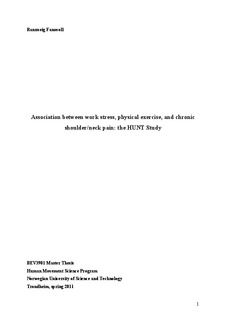| dc.description.abstract | Background: It is well documented that high work stress and low job control is associated with increased risk of shoulder/neck pain while regular physical exercise reduces this risk. However, there is limited knowledge about the combined effect of work stress and physical exercise on risk of chronic pain in shoulders/neck. The first objective of this study was to investigate the role of work stress and physical exercise as individual risk factors for chronic shoulder/neck pain in a large unselected population of women and men. A second objective was to investigate the combined effect of work stress and physical exercise on risk of chronic shoulder/neck pain.
Methods: The Nord-Trøndelag health study (the HUNT Study) was conducted in 1984-1986 (HUNT 1), with follow-up in 1995-1997 (HUNT 2). All women and men who participated in both surveys were included in the present study. After exclusions, the study population consisted of 12,530 women and 16,896 men for the analysis of work stress and job control on risk of chronic shoulder/neck pain, and 8,057 women and 11,028 men for the analysis including physical exercise. Relative risk (RR) of chronic shoulder/neck pain in HUNT 2 associated with work stress, job control, and physical exercise at baseline (HUNT 1) was estimated by a general lineal model.
Results: At follow-up, 4,357 (34,7%) women and 4,470 (26.5%) men reported chronic shoulder/neck pain. Work stress showed a strong dose-response association with risk of chronic shoulder/neck pain (P-trend <.001) for both women and men. Women and men who reported to be exposed to work stress almost all the time had RRs of 1.32 (95% confidence interval [95% CI] 1.11-1.58) and 1.68 (95% CI 1.41-2.00), respectively. The effect of job control on chronic shoulder/neck pain was weak, both among women and men. The different measures of physical exercise (i.e., frequency, duration, and intensity) all showed a moderate inverse dose-response effect on risk of chronic shoulder/neck pain in both women and men (10-20% reduced risk among the most active). The combined analysis showed that individuals who reported high stress levels and who exercised ≥2 sessions per week had a RR of 1.35 (95% CI 1.06-1.72) compared to a RR of 1.64 (95% CI 1.26-2.12) among inactive individuals with similar stress level.
Conclusion: This prospective study indicates that women and men who perceive their work situation as stressful have an increased risk of chronic shoulder/neck pain. There was a moderate inverse relation between physical exercise and risk of chronic shoulder/neck pain for both women and men. Regular physical exercise can, to some extent, compensate for the adverse effect of work stress on risk of chronic shoulder/neck pain. | nb_NO |
